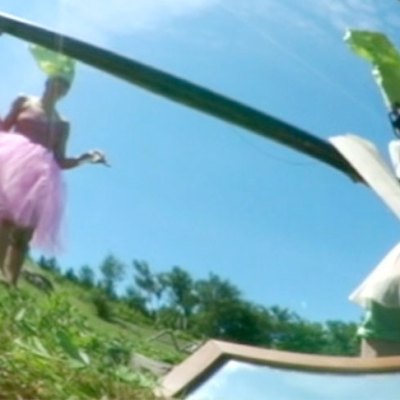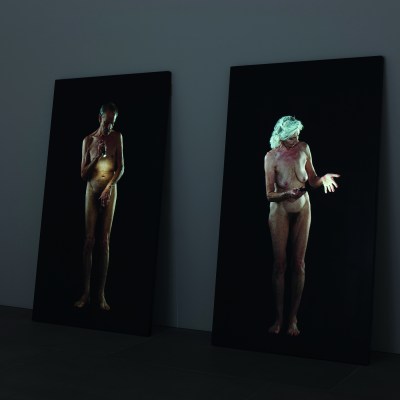Hollis Frampton (1936–84) is celebrated for the extremity and wit of his moving-image work and the iconoclasm of his writing. He is also remembered for his teaching work at SUNY Buffalo and his experiments in electronic sound and computer coding: seriality and algorithms were a particular interest. James Joyce, one of Frampton’s heroes, expected his readers to devote their entire lives to reading his books, and it can sometimes seem as if Frampton expected the same of his audience. Relentlessly cerebral, it’s a body of work that can be as pompous and arcane as it is erudite and funny.
This exhibition at Goldsmiths, thoughtfully curated by Oliver Fuke, is the first staged in the UK dedicated to Frampton’s still photography, a medium in which he is considerably less well known, perhaps for good reason. His most famous film, (nostalgia) (1971), from the series Hapax Legomena, is a meditation on time, work, friendship and memory. A succession of his photographic prints are burned over an electric cooking hob; while we struggle to discern the smaller details in each photograph, the narrator describes and reflects on them. But our cognitive load is increased even further as we realise each description matches the next photograph in the sequence, pulling us backwards and forwards at the same time. Frampton claims to have abandoned photography in this film, but he continued to use it as a supporting medium until his early death from cancer.
Mourning Dove from the series ADSVMVS ABSVMVS (1982), Hollis Frampton. © Estate of Hollis Frampton

At the centre of the show is ADSVMVS ABSVMUS (1982), a series of photographs of roadkill and other dead specimens Frampton documented with Ektacolor prints. Each item – a rat, midshipman and Chimaera fish, cuttlefish, snake, mourning dove, toad, grass frog, jelly, lotus, oyster shell mushroom, pepper, rose and white clover – is accompanied by a few lines of explanation. The Latin title of the series (classical allusions are a constant in Frampton’s oeuvre) translates as ‘we are present; we are absent’ and the work functions in part as a tribute to his recently deceased father. The pictures highlight the equivalence between chemical fixing in analogue photography and the process of mummification of dead organisms, whereby their ‘shell’ remains. In his introduction to the photographs Frampton writes:
In the unimaginable or ordinary case of their copresence, an object and its picture, contending for the center of the spectatorial arena, induce, out of mutual rejection, an oscillation of attention whose momentary frequency is the implicit cantus firmus of our thought.
This is typical of Frampton: ever aware of the co-dependence of words and images. But the supercilious tone is set off nicely against the part taxonomic, part anecdotal timbre of the labels themselves:
XII. MOURNING DOVE (Zenaidura macroura)
This immature specimen was found by Bill Brand during the demolition of a wall in the town of Eaton, New York, in July, 1975. The genus is never iridescent, but it is soothing in appearance as in voice, and graceful in its habits. The squabs are reputedly delicious, but are rarely to be gathered in quantity.
From the series Rites of Passage (1983–84), Hollis Frampton and Marion Faller. © Hollis Frampton and Marion Faller

Two of Frampton’s collaborations with his second wife, Marion Fuller, can be seen here. The monotone prints in Rites of Passage (1983–84), their last joint effort, use the familiar iconography of cake toppers to narrate key life events: birthdays, graduation, marriage, and retirement are all represented by tiny plastic figurines sitting atop perfectly iced confections. The rigid seriality of the framing – each picture of a cake is identical save for the toppers themselves – might suggest the hollowness of the American dream, and were perhaps a form of therapy for the couple as much as an artistic statement: Frampton died in the year of their completion. Their earlier series, Sixteen Studies from VEGETABLE LOCOMOTION (1975), an impish response to Eadweard Muybridge’s ‘Animal locomotion’ photographs, is more obviously engaging; their use of stationary subjects such as gourds and tomatoes an affectionate parody. The humour also comes from the pseudo-scientific set-up and whimsical titles: Faller’s gleeful profile in Winter squash vacillating [var. ‘True Hubbard’] and the sight of a large, phallic zucchini being broken in two on a sawhorse give us a sense of the creative energy between her and Frampton.
From the series Sixteen Studies from VEGETABLE LOCOMOTION (1975), Hollis Frampton and Marion Faller. © Estate of Hollis Frampton and Marion Faller

The emphasis is perhaps more pointed than playful in Frampton’s earlier series, The Secret Life of Frank Stella (1958–62), in which the two friends send up David Douglas Duncan’s photobook The Private World of Picasso. But the essential ambiguity of photography wins through and the scenes of these two arrivistes mocking the aging enfant terrible manages to be poignant all the same. Of note is a study of Stella seated against a wall, his form echoed by the pot plant beside him. The painter’s left hand, with half its index finger and part of its thumb lopped off in a childhood accident, grabs the eye as cleanly as the austere geometry of his early abstract paintings.
There are other collaborations here: one vitrine displays books, contact sheets and exhibition posters documenting Frampton’s early portraits of fellow New York artists Lee Lozano, James Rosenquist and Larry Poons. But perhaps the most intriguing part of the show is another containing Frampton’s notes towards his essay ‘Digressions on the Photographic Agony’ (1972). In what could be the handwriting of five different people, the author cites André Bazin, Werner Heisenberg, Niels Bohr and Euclid, but it is a passage by Borges that seems to sum up the fundamental appeal of Frampton’s own practice:
I have done my best – I don’t know with what success – to write straightforward stories. I do not dare state that they are simple; there isn’t anywhere on earth a single page or single word that is, since each thing implies the universe, whose most obvious trait is its complexity.
Yet Frampton’s complexity can also be infuriating, and this show fails to make a case for him as anything more than pedestrian as a stills photographer. Perhaps he would have liked this: he was highly critical of the pictorial and, by his own admission, photography was for him really only a route into film-making, writing and lecturing, all of which is made elegantly accessible here via wall texts, QR codes and other printed material. For anyone who is curious about the more extreme forms of modernism, but finds them forbidding and dry, this exhibition provides a very welcome introduction to one of its most ludic exponents. In these supposedly ‘post-medium’ times for avant-garde art practice, it is refreshing to be reminded of an artist who took the properties of their medium so seriously. The show is a testament to the importance of significant others in even this most singular of artistic enterprises. The presence of close friends, ancestors, artistic forebears and, above all, Marion Faller shines through almost everything in the show, recalling Frampton’s reference to Rosenquist in (nostalgia):
(we) live far apart now, and we seldom meet. But I cannot recall one moment in his company that I didn’t completely enjoy.
‘Hollis Frampton: Photographs’ is at Goldsmiths Centre for Contemporary Art, London, until 13 December.



